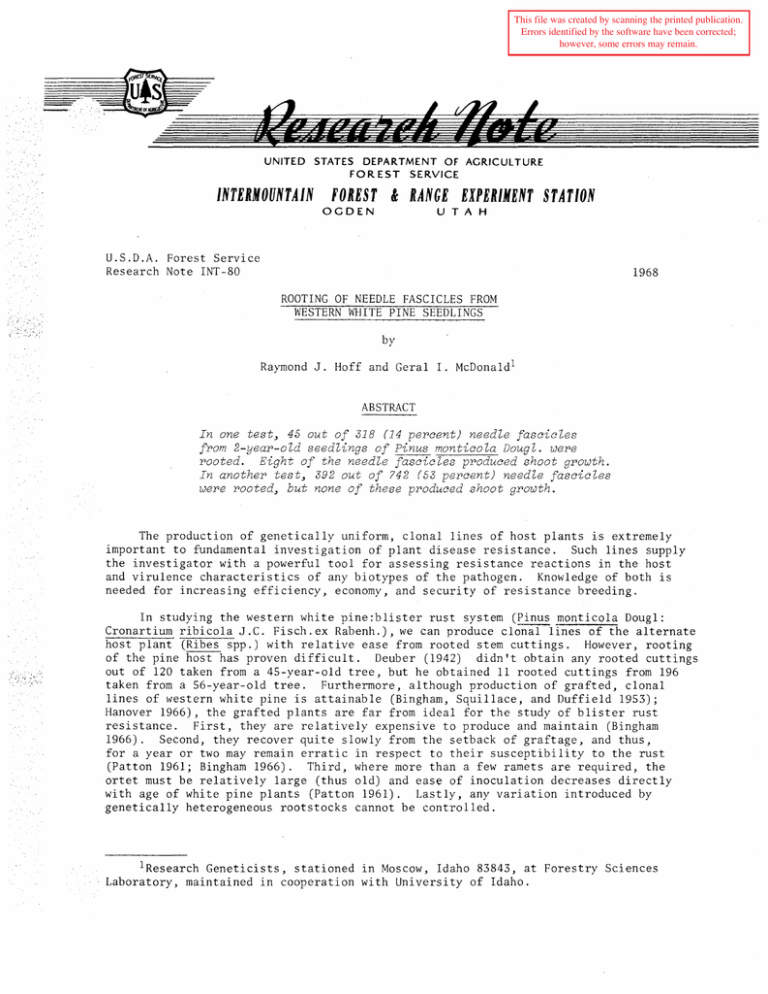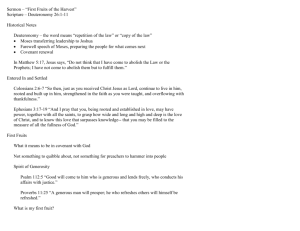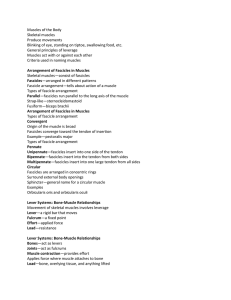This file was created by scanning the printed publication.
advertisement

This file was created by scanning the printed publication. Errors identified by the software have been corrected; however, some errors may remain. ----. UNITED STATES DEPARTMENT OF AGRICULTURE FOR EST SERVICE INTERMOUNTAIN FOREST & BANGE EXPERIMENT STATION OGDEN UTAH U.S.D.A. Forest Service Research Note INT-80 1968 ROOTING OF NEEDLE FASCICLES FROM WESTERN WHITE PINE SEEDLINGS by Raymond J. Hoff and Geral I. McDonald 1 ABSTRACT In one test~ 45 out of 318 (14 percent) needle fascicles from 2-year-old seedlings of Pinus monticola Dougl. were rooted. Eight of the needle fascicles produced shoot growth. In another test~ 392 out of 742 (53 percent) needle fascicles were rooted~ but none of these produced shoot growth. The production of genetically uniform, clonal lines of host plants is extremely important to fundamental investigation of plant disease resistance. Such lines supply the investigator with a powerful tool for assessing resistance reactions in the host and virulence characteristics of any biotypes of the pathogen. Knowledge of both is needed for increasing efficiency, economy, and security of resistance breeding. In studying the western white pine:blister rust system (Pinus monticola Dougl: Cronartium ribicola J.C. Fisch.ex Rabenh.), we can produce clonal lines of the alternate host plant (Ribes spp.) with relative ease from rooted stem cuttings. However, rooting of the pine host has proven difficult. Deuber (1942) didn't obtain any rooted cuttings out of 120 taken from a 45-year-old tree, but he obtained 11 rooted cuttings from 196 taken from a 56-year-old tree. Furthermore, although production of grafted, clonal lines of western white pine is attainable (Bingham, Squillace, and Duffield 1953); Hanover 1966), the grafted plants are far from ideal for the study of blister rust resistance. First, they are relatively expensive to produce and maintain (Bingham 1966). Second, they recover quite slowly from the setback of graftage, and thus, for a year or two may remain erratic in respect to their susceptibility to the rust (Patton 1961; Bingham 1966). Third, where more than a few ramets are required, the ortet must be relatively large (thus old) and ease of inoculation decreases directly with age of white pine plants (Patton 1961). Lastly, any variation introduced by genetically heterogeneous rootstocks cannot be controlled. 1 Research Geneticists, stationed in Moscow, Idaho 83843, at Forestry Sciences Laboratory, maintained in cooperation with University of Idaho. For these reasons we are interested in rooting needle fascicles of young western white pines. If fascicles can be rooted with even a moderate degree of success, clones· with relatively large numbers of members may be obtained even from 2-year-old plants. For certain work, in fact, rooted fascicles that fail to produce shoots but remain alive more than a year or so may suffice. Various workers have successfully rooted fascicles of young "hard" pines (Jeckalejs 1956; Isikawa and Kusaka 1959; Mergen and Simpson 1964; Reines and Bamping 1964; Rudolph and Nienstaedt 1964; and Kummerow 1966). Thimann and Delisle (1942) have successfully rooted needle fascicles of P. strobus, a "soft" pine, and workers at the Pacific Southwest Forest and Range Experiment Station have successfully rooted other species of "soft" pines including western white pine. 2 This paper reports moderate success attained in rooting needle fascicles of young western white pine. During the first week of February two tests were installed. For one, needle fascicles with 2- to 3-mm.-long buds were removed from the apical leader of 2-year-old greenhouse-grown, dormant western white pine seedlings. The fascicles were treated with Rootone, 3 which contains 0.067% naphthylacetamide, 0.033% 2-methyl-1-naphthylacetic acid, 0.013% 2-methyl-1-naphthylacetamide, and 0.05% indole-3-butyric acid. These then were planted in a washed-sand culture, and placed in a greenhouse with a 16-hour photoperiod at an air temperature of about 72° F. In the second test, fascicles were taken from nursery-grown 2-year-old seedlings. Very few of these fascicles contained a fascicular bud. They were planted in a soil mixture of equal parts of sand and peat moss culture but were not given a hormone treatment. They were then placed in the same environmental conditions as in the first test. Differences between the two tests arose because the rooting of fascicles was not the objective of the second test. During the first week of July, a tally was made of the total rooted fascicles and shoot growth in the first test and of rooted fascicles only in the second test. The total rooted was 45 out of 318 (14 percent) for the first test (table 1) and 392 out of 742 (53 percent) for the second test (table 2). Eight of the rooted fascicles in test 1 produced shoot growth (table 1, fig. 1). Shoot growth was not noted for the second test due to the absence of budded fascicles. Tables 1 and 2 also show that rooting ability may be closely controlled by genotype. This is especially evident when tree 224 in table 1 and trees 255 and 382 in table 2 are compared with tree 272 in table 1 and trees 60 and 235 in table 2. Having attained this moderate success, we will now test different treatments and culture methods, hoping for an increase in the rooting and shoot growth percentages. The differences found in the two tests described above indicate a real potential for increasing rooting, if not for increasing shoot growth. Disbudding plants to encourage the continued development of fascicular buds (Kummerow 1966; Ginzburg and Reinhold 1967) holds much promise for increasing the proportion of rooted fascicles with shoot growth. 2 Personal communication from Dr. Stanley L. Krugman. 3 Use of trade names herein is for identification only imply endorsement by the U.S.D.A. Forest Service. 2 and does not necessarily w 2 Numbers 1 1 ( l) 2 1 0 0 0 78 12 12 6 12 12 12 12 1 0 0 0 0 1 1 11(14) 1 3(4) 2 0 1 1 5 3 0 1 19 Fasc. Shoots planted: rooted prod. : : Fasc. 81 12 12 9 12 12 12 12 15(19) 1 1 2 3 4 3 2 0 4(5) 2 0 1 0 2 1 0 0 Male tree no. 22 Fasc. Shoots planted: rooted prod: : : Fasc. : 80 12 12 8 12 12 12 12 12(15) 0 1 2 1 0 3 5 Fasc. : Fasc. planted :rooted 1 0 0 0 0 0 0 0 0 58 Shoots prod. in parentheses represent percentile values of fascicles rooted to fascicles planted. in parentheses represent percentile values of shoots produced to fascicles planted. 7 (9) Total 1 Numbers 2 1 1 0 2 1 0 0 0 0 17 :Fasc. Shoots :rooted prod. : 277 208 272 197 15 20 224 Female tree no. 79 12 12 7 12 12 12 12 45 (14) 5 ( 10) 6(13) 10(33) 7 (15) 8 ( 17) 9 (19) 0 8 ( 3) 0 2(4) 1 ( 3) 2(4) 1 ( 2) 2(4) 0 318 48 48 30 48 48 48 48 : Total Fasc. Shoots Fasc. Fasc. rlanted: rooted 1 prod. 2 planted Table 1.--Number of fascicles rooted and shoots rroduced following Elanting in washed-sand culture of hormone-treated needle fascicles from greenhouse-grown western white rine seedlings *"" 1 -- 1 10 -- 9 7 4 12 8 10 9 8 10 4 4 9 7 4 11 1 -- 1 3 -6 9 8 -- 1 2 -- 0 2 1 3 5 10 1 4 3 4 2 4 4 2 9 1 -- 0 2 -- 5 7 1 167 12 7 80(45) -- -- 17 Fascicles :Rooted Planted ~ -- 203 -- 7 119(53) -11 -- -- 12 3 11 8 3 11 4 7 7 5 8 12 11 12 11 11 8 9 9 3 10 2 5 3 6 3 2 9 0 5 4 3 3 10 11 3 7 5 5 3 2 1 6 2 1 5 9 -- 1 5 8 19 Fascicles Rooted Planted 100(55) -- 1 4 5 1 2 -- 4 5 6 1 4 3 3 7 7 1 7 5 8 1 8 1 1 6 1 4 1 3 183 -- 11 5 9 4 4 -- 10 10 9 2 6 7 3 12 9 6 10 9 9 2 10 2 1 7 11 11 1 3 22 Fascicles Rooted Planted 93(49) --- 0 6 2 5 3 2 2 7 4 3 5 0 6 0 4 5 9 0 2 5 3 5 1 1 3 5 5 189 -- -- 1 11 5 12 5 6 5 11 6 6 12 7 7 3 8 7 12 3 4 9 3 6 5 7 11 5 12 58 Fascicles : Rooted Planted : Numerals in parentheses are percentile values of fascicles rooted to fascicles planted. Total 33 60 67 95 99 112 115 121 138 177 179 184 211 227 230 232 235 255 261 262 265 269 274 382 383 384 252 263 57 Female tree no. Male tree no. : : 392(53) 5(42) 23(61) 16(70) 7(47) 14(42) 8(50) 11(39) 19(50) 14(64) 16(46) 17(50) 20(61) 19(59) 8(44) 18(50) 20(80) 23(82) 13(42) 14(42) 16(46) 18(78) 12(63) 3(21) 3 (14) 15 (52) 12(75) 11(50) 16(67) 1 (13) 1 742 12 38 23 15 33 16 28 38 22 35 34 33 32 18 36 25 28 31 33 35 23 19 14 22 29 16 22 24 8 Totals Fascicles Rooted Planted Table 2.--Number of fascicles rooted following planting in a soil mixture of sand and peat moss culture of needle fascicles from nursery-grown western white Eine seedlings Figure 1.--A rooted needle fascicle of western white pine: B, with shoot growth. 5 A, without shoot growth; REFERENCES Bingham, R. T. 1966. Breeding blister rust resistant western white pine. III. Comparative performance of clonal and seedling lines from rust-free selections. Silv. Genet. 15: 141-192. Bingham, R. T., A. E. Squillace, and J. W. Duffield. 1953. Breeding blister rust resistant western white pine. J. Forest. 51: 163-168. Deuber, C. G. 1942. The vegetative propagation of eastern white pine and other five-needled pines. J. Arn. Arb. 23: 199-215. Ginzburg, M. W., and L. Reinhold. 1967. The development of techniques for the vegetative propagation of pine trees by means of needle fascicles. Hebrew Univ. Jerusalem Rep. for U.S. Dep. Agr., forest. Serv. P.L. 480. Proj. AlO-FS-8, 36 pp. Hanover, J. W. 1966. Genetics of terpenes. I. Gene control of monoterpene levels in Pinus monticola Dougl. Heredity 21: 73-84. Isikawa, H., and M. Kusaka. 1959. The vegetative propagation of cutting of Pinus species. propagation of Japanese black pine using leaf-bundles. Exp. Sta. Meguro, Tokyo, Japan 116: 59-64. 1. Vegetative Bull. Forest. Jeckalejs, H. J. 1956. The vegetative propagation of leaf-bundle cuttings of red pine, Pinus resinosa. Forest. Chron. 32: 89-93. Kummerow, J. 1966. Vegetative propagation of Pinus rigida by means of needle fascicles. Forest Sci. 12: 391-398. Mergen, F., and B. A. Simpson. 1964. Asexual propagation of Pinus by rooting needle fascicles. 13: 125-164. Silv. Genet. Patton, R. F. 1961. The effect of age upon susceptibility of eastern white pine to infection by Cronartium ribicola. Phytopathology 51: 429-434. Reines, M., and J. H. Bamping. 1964. Rooting of needle bundles. J. Forest. 62: 181-182. Rudolph, T. D., and H. Nienstaedt. 1964. Rooting, shoot development and flowering of jack pine needle fascicles. Silv. Genet. 13: 118-124. Thimann, K. V., and A. L. Delisle. 1942. Notes on the rooting of some conifers from cuttings. 23: 103-109. 6 J. Arn. Arb.




